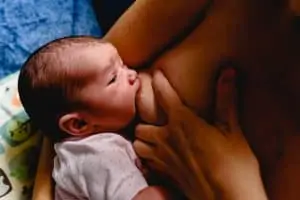Does your baby seem content and relaxed after breastfeeding, or is your baby fussy and agitated still? That might leave you wondering, should you breastfeed from one breast or both?
The decision to offer your baby one or both breasts at each feeding depends entirely on you and your baby. A baby that gets enough breast milk from one side and grows at a consistent pace doesn’t need to be fed from both. You have to consider your baby and what is working best for your child.
Let’s take a more in-depth look at this topic.
Start With Both Breasts
In the weeks following your baby’s birth, you’ll want to breastfeed from both breasts, but be sure to empty one before offering the next. Breastfeeding on both sides helps to stimulate breast milk production, which is crucial in the early weeks after childbirth.
At this time, your child is growing rapidly as well. You want your baby to eat as much as possible, so offering both breasts is recommended, but that doesn’t mean your baby will eat from both sides! As your baby grows and your milk supply regulates, as long as your baby is growing appropriately, you can pick whatever feeding method works best for you.
My story:
Some women prefer one-sided breastfeeding. When I was nursing my toddler, I ended up only nursing one side completely! I let my right breast dry up and only nursed on my left side. During that time, we were slowly weaning down, but it is possible. However, that’s not recommended for newborns or infants who have breastmilk as their sole food source.
The Problems With Breastfeeding From One Breast
When you approach this way, it could cause some problems. Some of those problems include:
- Breast engorgement and discomfort
- Clogged milk ducts
- Mastitis
- Low milk supply
To avoid these issues, it’s recommended that you breastfeed from both breasts or rotate evenly throughout the day. If your baby doesn’t need to drink from both breasts to fill up, then make sure you start with the opposite breast the following nursing session.
Don’t Switch Too Soon
If you’re going to offer both breasts in a single nursing session, don’t switch too soon. While there are disadvantages to breastfeeding from only one breast, there are some advantages as well.
The main advantage is that your baby receives both hindmilk and foremilk. Foremilk comes out first. It’s thinner and doesn’t have as much fatty content as your hindmilk, but it helps to satisfy your baby’s initial hunger.
Then, your milk gradually changes to hindmilk. Hindmilk is the calorie-dense, fatty milk that your baby needs to pack on the pounds. However, there isn’t a specific moment when your milk goes from foremilk to hindmilk, but it’s a slow change.
So, if you switch breasts too soon, your baby will miss out on this fatty goodness. Your baby needs as many calories as possible, so avoid changing too soon. Don’t set a timer and switch at the same time; watch your baby’s behavior. If he’s content at the breast, there is no reason to switch.
Follow Their Lead As They Grow

As your baby grows, it’s always best to follow their lead. You might find that your baby only nurses on one side per feeding, and that’s normal, especially for an older infant. Once you introduce solid foods, your baby might only need to nurse on one side; don’t panic.
When your baby hits a growth spurt, he might end up wanting both breasts. Look for signs that your baby is still hungry. Everyone, including you, has random times when you feel hungrier than usual, so it’s not abnormal for your baby to happen.
Babies Sometimes Refuse a Breast
You might notice that your baby only nurses on one side by preference – this happens at times. It often happens to babies – this can be a random phase that they enter, or it also can be a sign that your baby has an ear infection.
If your baby is refusing one breast, watch his behavior. Is he crying and fussy when he lays down on that side? He might have an ear infection; it could warrant a doctor’s trip to confirm that everything is okay.
Your baby might also have an injury on that side. If he received a vaccination lately or perhaps took a tumble, make sure everything looks fine on that side. Another reason for a sudden refusal of one breast is that you might have a developing breast infection, making your breast milk have a salty taste.
Typically, a refusal of one side is slow instead of a sudden change. A persistent or gradual refusal tends to be because your one breast is slower or faster than the other. Most babies have a preference, to an extent, based on what side they like to be held and what feels most comfortable.
Do What Works for Your Baby
What is most important is following your baby. When your baby is happy, content, and growing at an acceptable rate based on stats at the doctor, then chances are you don’t need to breastfeed from both breasts. If your baby is gaining weight slowly or seems to continue to be hungry after eating, then you should breastfeed from both sides.
Hey, this is Linda. My biggest accomplishment in life is being a mother of four children. Their current ages range from almost ten years old down to 20 months old.
I’m passionate about writing parenting articles because I understand so well all of the problems and trials you face as a parent. From breastfeeding woes to budgeting problems and behavior problems, along with everything in between, chances are I’ve faced it over the last ten years. Read more about Linda here.






